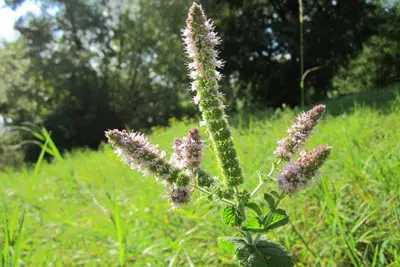Peppermint is a very popular herb plant, as it can be used in many ways, is very easy to care for and thrives well in the garden bed as well as in a tub on the balcony. Thus, it can be brewed as a tea, refine a meal and also from many cocktails, the delicious leaves are no longer imaginable without. But it is often pointed out that a flowering mint plant should not be consumed. Does this have health reasons, is it because of the taste or does the plant even become poisonous at flowering time. The following article explains the reasons why the herb should not be eaten during the flowering period.
Contents
Do not eat flowering mint?
The flowering mint can certainly be utilized and eaten or boiled up as tea. However, it should not be, as it loses its flavor during flowering. This is because the main goal of the plant is to reproduce. Thus, with the flowers it attracts the pollinators, such as bees or bumblebees, so that the flowers are fertilized. Thus, all the power is invested in the formation of the flowers, fruits and seeds. However, the familiar peppermint taste of the leaves falls by the wayside.
Tip: In the period when the peppermint blooms, the amateur gardener should completely enjoy the sight. However, in order to have mint available in the kitchen all year round, the leaves can be harvested before flowering and dried or frozen. This allows the plant to bloom at its leisure, after which it becomes tasty again when fresh.
mint flowers not poisonous
The plants are not poisonous, even during flowering. The leaves can be harvested and eaten even while the plant bears flowers, it is completely safe. However, they do not taste so good to many amateur cooks during this period. However, others are of the opinion, especially in this period after flowering, the leaves are particularly edible and enjoyable because of the tart taste.
Tip: Since opinions about the taste before and after flowering, as well as the edibility of the flowers vary greatly, each amateur gardener should form his own opinion about this. However, consumption does not harm at any time, if the tasty leaves are enjoyed in moderation.
Flowering time
Peppermint usually begins to bloom in June. During this time, long panicles resembling ears of corn are formed. The small flowers are formed on these. Before they open, most of the oil is stored in the leaves, then should be harvested. Thus, about the flowering period of the plant is the following:
- blooms from June to August
- pink-white small flowers
- the aroma of the leaves is greatest before the flowering period
Many experts advise to pinch off the flower buds and do not let the plant bloom in the first place. Therefore, if you are not interested in the actually decorative flowers of peppermint for aesthetic reasons, you can certainly take this measure. After all, the seeds are not needed for reproduction either, as the mint can also be propagated by division if more plants are desired. Thus, no effort is put into flower formation and the leaves remain tasty longer in this way.
Tip: Gourmets today even go so far as to use the flowers in the kitchen. Like other edible flowers, these can be sprinkled over a salad and are also said to be very tasty.
Harvest time
As a rule, the leaves of peppermint can be harvested at any time. However, in the spring before the flowers form, the leaves have the most flavor due to the essential oils they contain. As the plant blooms, more of its energies are put into the flowers, so the leaves receive less of the oil and thus lose much of their familiar minty flavor. And even after the flowers have faded, the leaves can be used again, but now they taste a bit more tart. So the harvest should be done as follows:
- always remove leaves in the spring
- harvest the largest part of the leaves before the flowering period
- freeze or dry
- occasionally, leaves can also be taken during the flowering period
- after flowering the leaves are more tart
- can also be harvested now
Ideally, the plant should be cut back before winter so that it can sprout new and tasty leaves in spring. Although the leaves taste a bit more tart now, they can still be utilized. Thus, these more tart tasting leaves can still be used well dried, for example, for brewing tea.
Tip: The leaves of mint should not be consumed if the plant is affected by mildew, which unfortunately occurs very often. Then the appropriate countermeasures must first be taken before the leaves can be harvested for consumption again.
Side effects
Although the leaves of the herb plant are edible at any time and the plant is not poisonous, there may well be side effects if consumed in large quantities. This is because mint leaves are not only used in cooking for a tasty meal, but these are also said to help in various areas of health. The tea can help with the following indispositions:
- stomach and intestinal problems
- difficulty in falling asleep
- headache
- colds
However, due to increased consumption of the tea, any existing symptoms of heartburn may be aggravated. However, this has nothing to do with whether the plant has bloomed at harvest time or not.


